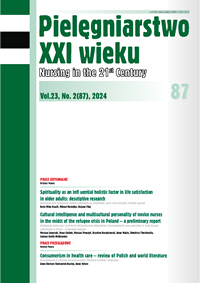Postrzeganie przez pacjentów, pielęgniarki, innych pracowników służby zdrowia i menedżerów szpitali ogólnych treści i wyzwań związanych z przekształceniem ścieżki klinicznej w zintegrowaną ścieżkę kliniczną: Jakościowe badanie pilotażowe
DOI:
https://doi.org/10.2478/pielxxiw-2024-0022Słowa kluczowe:
jakość opieki, zintegrowana opieka, szpital ogólny, zintegrowane ścieżki kliniczne, koncentracja na pacjencieAbstrakt
POSTRZEGANIE PRZEZ PACJENTÓW, PIELĘGNIARKI, INNYCH PRACOWNIKÓW SŁUŻBY ZDROWIA I MENEDŻERÓW SZPITALI OGÓLNYCH TREŚCI I WYZWAŃ ZWIĄZANYCH Z PRZEKSZTAŁCENIEM ŚCIEŻKI KLINICZNEJ W ZINTEGROWANĄ ŚCIEŻKĘ KLINICZNĄ: JAKOŚCIOWE BADANIE PILOTAŻOWE
Cel pracy. Szpitalna opieka zdrowotna nad pacjentem stanowi część “podróży” pacjenta przez system opieki zdrowotnej i jako taka nie jest świadczona niezależnie, ale w spersonalizowany, zintegrowany sposób. Aby osiągnąć lepsze wyniki spersonalizowanej opieki medycznej nad pacjentami przebywającymi w szpitalu, konieczne jest systematyczne przekształcanie istniejących ścieżek klinicznych (ang. clinical pathways – Cps) w zintegrowane ścieżki kliniczne (ang. integrated clinical pathways – ICPs). Celem pracy było zbadanie postrzegania przez interesariuszy treści i barier w przekształcaniu CPs w ICPs na przykładzie szpitala ogólnego w Słowenii. W ten sposób uzyskano mikrodane dotyczące rozwiązań systemowych na poziomie szpitali ogólnych w Słowenii.
Materiał i metody. W badaniu przekrojowym wykorzystano metodę jakościową obejmującą wywiady i badania fokusowe z pacjentami, pielęgniarkami, innymi pracownikami służby zdrowia oraz menedżerami pracującymi w ICPs, którzy zajmują się leczeniem przewlekłej choroby nerek i wymianą stawu biodrowego w standardowym słoweńskim szpitalu.
Wyniki. Wyniki pokazały, że ICPs można podzielić na pięć podstawowych faz. Na wszystkich etapach konieczne było rozbudowanie istniejących CPs w celu przekształcenia ich w ICPs, co stanowiło dodatkowe obciążenie, zwłaszcza dla pielęgniarek.
Wnioski. Spersonalizowana opieka zdrowotna realizowana poprzez ICP jest skoncentrowana na pacjencie, krótsza holistyczna, skoordynowana, ciągła, zapewnia wyższą jakość dla pacjentów i większą wydajność dla świadczeniodawców.
Bibliografia
1. Busetto L, Luijkx K, Calciolari S, et al. Barriers and Facilitators to Workforce Changesin Integrated Care. IJIC. 2018; 18(2): 17.
2. Seys D, Panella M, VanZelm R, et al. Care pathways are complex interventions incomplex systems: New European Pathway Association framework. International Journal of Care Coordination. 2019; 22(1): 5-9.
3. OECD. Improving healthcare quality in Europe Characteristics, effectiveness and implementation of different strategies. 2019. Accessed at: htps:// ap ps.who.int /iris / bi t s tream/handle/10665/ 327356/9789289 051750 -eng. pdf?sequence=1&isAllowed=y (21.03.2023).
4. Du G, Huang L, Zhou M. Variance Analysis and Handling of Clinical Pathway: An Overview of the State of Knowledge. IEEE Access. 2000; 8: 158208-158223.
5. Hussain ZI, Lim M, Stojkovic S. Role of clinical pathway in improving the quality of care for patients with faecal incontinence: A andomized trial. World J. Gastrointest. Pharmacol. Ther. 2017; 8(1): 81-89.
6. Viney W, Day S, Bruton J, et al. Personalising clinical pathways in a London breast cancer service. Sociol. Health. Illn. 2022; 44(3): 624-640.
7. Hussein M, Kregar-Velikonja N, Erjavec K. Barriers to inter-organisational collaboration in the preoperative management of patients with osteoarthritis of the hip or knee. IJIC. 2023; 23(2): 1-12.
8. Sullivan DO, Manix M, Timmons S. Integrated Care Pathways and Care Bundles for Dementia in Acute Care: Concept Versus Evidence. AJADD. 2017; 32(4): 189-193.
9. Elliott MJ, Gil S, Hemmelgarn BR, et al. A scoping review of adult chronic kidney disease clinical pathways for primary care. Nephrol. Dial. Transplant. 2017; 32(5): 838-846.
10. Kolk M, Boogaard MHWA, Becking-Verhaar F, et al. Implementation and Evaluation of a Clinical Pathway for Pancreaticoduodenectomy Procedures: a Prospective Cohort Study. World J. Gastrointest. Surg. 2017; 21(9): 1428-1441.
11. Kebapcı A, Kanan N. Effects of nurse-led clinical pathway in coronary artery bypass graft surgery: A quasi-experimental study. JCN. 2018; 27(5-6): 980-988.
12. Plishka CT, Rotter T, Penz ED, et al. CPW Research Group. Effects of Clinical Pathways for COPD on Patient, Professional, and Systems Outcomes: A Systematic Review. Chest. Journal. 2019; 156(5): 864-877.
13. Van Hoeve JC, Vernooij RWM, Fiander M, et al. Effects of oncological care pathways in primary and secondary care on patient, professional and health systems outcomes: a systematic review and meta-analysis. Syst. Rev. 2020; 9: 246.
14. Thursky K, Lingaratnam S, Jayarajan J, et al. Implementation of a whole of hospital sepsis clinical pathway in a cancer hospital: impact on sepsis management, outcomes and costs. BMJ Open Qual. 2018; 7(3): e000355.
15. Zupančič V. Vpliv (integriranih) kliničnih poti na izide zdravstvene obravnave: sistematičen pregled literature. JHS. 2021; 8 (1): 37-59.
16. Martin GP, Kocman D, Stephens T, et al. This study was carried out as part of a wider randomised controlled trial, EPOCH. Pathways to professionalism? Quality improvement, care pathways, and the interplay of standardisation and clinical autonomy. Sociol. Health. Illn. 2017; 39(8): 1314-1329.
17. Gallo M, Clemente G, Cristiano Corsi D, et al. An integrated care pathway for cancer patients with diabetes: A proposal from the Italian experience. Diabetes Res. Clin. Pract. 2020; 159: 107721.
18. Wouters OJ, O’Donoghue DJ, Ritchie J, et al. Early chronic kidney disease: diagnosis, management and models of care. Nat. Rev. Nephrol. 2015; 11(8): 491-502.
19. OECD. Health at a Glance 2021: OECD Indicators. Accessed at; https:// w w w.o ecd -ilibr ar y.org/sites/8 b 492d7a-en/ind e x .html?itemId=/content / component/8b492d7a-en (28.03.2023).
20. Pabinger C, Lothaller H, Portner N, et al. Projections of hip arthroplasty in OECD countries up to 2050. Hip. Int. 2018; 28(5):498-506.
21. Tong A, Sainsbury P, Craig J. Consolidated criteria for reporting qualitative research (COREQ): a 32-item checklist for interviews and focus groups. Int. J. Qual. Health Care. 2007; 19(6): 349-357.
Pobrania
Opublikowane
Numer
Dział
Licencja
Prawa autorskie (c) 2024 Autorzy

Utwór dostępny jest na licencji Creative Commons Uznanie autorstwa 4.0 Międzynarodowe.




